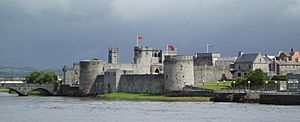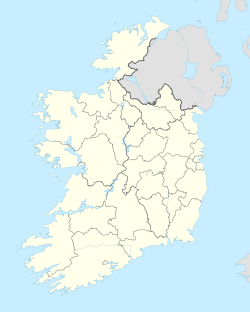King John's Castle (Limerick) facts for kids
Quick facts for kids King John's Castle / Limerick Castle |
|
|---|---|
| Caisleán Luimnigh | |
| Limerick, Ireland | |

View of King John's Castle from the River Shannon.
|
|
| Coordinates | 52°40′11″N 8°37′32″W / 52.669722°N 8.625556°W |
| Type | Medieval castle |
| Site history | |
| Built | c. 1210 |
| Built by | King John of England |
| Events | Siege of Limerick (1642) Siege of Limerick (1650–51) |
King John's Castle (Irish: Caisleán Luimnigh), also known as Limerick Castle, is an amazing 13th-century castle. You can find it on King's Island in Limerick, Ireland, right next to the River Shannon.
Even though the castle itself was built around 1200, people lived on this island much earlier. Vikings were here as far back as 922! King John of England ordered the castle to be built. Today, you can still see some of its strong outer walls, towers, and defenses. The castle is open for visitors to explore. When archaeologists dug here in 1900, they even found parts of an old Viking settlement.
This castle has seen a lot of history. It went through five big attacks, called sieges, in the 1600s. During one siege in 1642, its walls were badly damaged. The castle was held by Protestants who were escaping a rebellion. An Irish army then attacked it.
From 2011 to 2013, the castle got a big makeover. They spent €5.7 million to make it even better for visitors. Now it has a modern visitor center, cool interactive displays, and a cafe.
Contents
A Look Back: Viking Settlement on King's Island
The story of King's Island begins long before the castle. In 922, a Viking leader named Tomrair mac Ailchi built the first lasting Viking base here. This island was then called Inis Sibhtonn.
From this base, the Vikings would travel along the River Shannon. They raided places from Lough Derg all the way to Lough Ree. They often attacked religious settlements to take their treasures.
In 937, the Limerick Vikings fought against Vikings from Dublin on Lough Ree. The Dublin Vikings won that battle. Then, in 943, they lost again. This time, a local Irish clan leader joined forces with the King of Munster. The Limerick Vikings had to pay tribute to these clans.
After these defeats, the Vikings in Limerick lost much of their power. They became a smaller group, but they still played a part in the many power struggles of the next few centuries.
Building a Stronghold: The Castle's Early Days
In 1174, an Irish king named Domnall Mór Ua Briain burned down the Viking settlement. He did this to stop the Anglo-Normans from taking it over. After he died in 1194, the Anglo-Normans captured the area in 1195. This was under the rule of John, who was then the Lord of Ireland.
In 1197, Limerick received its first official document, called a charter. This document gave Limerick the right to govern itself. It also got its first mayor, Adam Sarvant, thanks to Richard I of England.
King John ordered a new castle to be built, and it was finished around 1210. This is the castle that now bears his name. The castle was built right on the edge of the River Shannon. Its main job was to protect the city. It guarded against Irish kingdoms to the west and any rebellions from Norman lords to the east and south.
Because of the peace that Norman rule brought, Limerick grew into a busy port and trading center. The castle helped by watching over all the goods passing through the port. By this time, the city had two main parts. "English Town" was on King's Island, where the castle stood. "Irish Town" grew on the south bank of the river.
Limerick became very rich during this time. King John even set up a mint inside the castle. This is where they made pennies and half-pennies. You can see some of these old coins in the Limerick museum today.
In 1574, a document for the Spanish ambassador described Limerick's wealth:
Limerick is stronger and more beautiful than all the other cities of Ireland, well walled with stout walls of hewn marble... There is no entrance except by stone bridges, one of the two of which has 14 arches, and the other 8 ... for the most part the houses are of square stone of black marble and built in the form of towers and fortresses.
This means Limerick was a very strong and beautiful city. It had strong walls made of marble. You could only enter by stone bridges, and its houses were like towers.
In 1620, a judge named Luke Gernon also wrote about how amazing Limerick was:
a lofty building of marble; in the high street it is built from one gate to the other in one form, like the colleges in Oxford, so magnificent that at my first entrance it did amaze me".
He said the buildings were tall and made of marble. The main street looked like colleges in Oxford, and it was so grand it amazed him.
Battles and Damage: The Sieges of Limerick
The castle's walls were badly damaged during the 1642 Siege of Limerick. This was the first of five sieges that happened in the city during the 1600s.
In 1642, Protestants who were escaping the Irish Rebellion of 1641 were staying in the castle. An Irish army, led by Garret Barry, then surrounded and attacked the castle. Barry didn't have big cannons to break down the walls. Instead, he used a clever tactic: he dug tunnels under the castle's foundations. This made the walls unstable.
The people inside the castle gave up just before Barry's tunnels caused the walls to collapse. However, the damage to the foundations was so severe that parts of the walls had to be taken down afterward.
Modern Makeover: Redevelopment for Visitors
Between 2011 and 2014, King John's Castle got a huge upgrade. They spent €5.7 million to make it a fantastic place for visitors.
These improvements included a brand new visitor center. They also added interactive exhibits with cool computer animations. Plus, there's a cafe where you can enjoy views of the castle courtyard and the river. These changes have made the castle an even more exciting place to learn about history.
See also
 In Spanish: Castillo del Rey Juan (Limerick) para niños
In Spanish: Castillo del Rey Juan (Limerick) para niños
- History of Limerick City
- Limerick City Museum, just to the south



